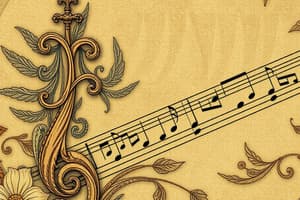Podcast
Questions and Answers
What does frequency theory state about pitch?
What does frequency theory state about pitch?
- Pitch varies with the temperature of the surrounding environment
- Pitch is related to the speed of vibrations in the basilar membrane (correct)
- Pitch is unrelated to the speed of vibrations
- Pitch is determined solely by amplitude of sound waves
What is the volley principle?
What is the volley principle?
A theory that states frequencies from about 4000Hz cause hair cells to fire in a volley pattern.
What does the term olfaction refer to?
What does the term olfaction refer to?
The sensation of smell.
What comprises the somesthetic senses?
What comprises the somesthetic senses?
What do skin senses detect?
What do skin senses detect?
What is the kinesthetic sense?
What is the kinesthetic sense?
What are vestibular senses responsible for?
What are vestibular senses responsible for?
What is sensory conflict theory?
What is sensory conflict theory?
What is the cocktail party effect?
What is the cocktail party effect?
What is size constancy?
What is size constancy?
What does shape constancy refer to?
What does shape constancy refer to?
What is brightness constancy?
What is brightness constancy?
What does figure-ground perception involve?
What does figure-ground perception involve?
What are reversible figures?
What are reversible figures?
What does proximity refer to in Gestalt psychology?
What does proximity refer to in Gestalt psychology?
Flashcards are hidden until you start studying
Study Notes
Frequency Theory and Pitch Perception
- Frequency theory links pitch perception to the speed of basilar membrane vibrations.
- Higher vibration speeds correlate with higher pitches perceived by the brain.
Volley Principle
- The volley principle explains pitch perception for frequencies around 4000 Hz.
- Auditory neurons fire in a coordinated pattern, alternating the sequence of firings among hair cells.
Sensation of Smell
- Olfaction is the technical term for the sensation of smell.
Somesthetic Senses
- Somesthetic senses encompass skin senses, kinesthetic sense, and vestibular senses.
- They contribute to the overall awareness of bodily sensations.
Skin Senses
- Skin senses include touch, pressure, temperature, and pain sensations.
- These senses are essential for tactile interactions with the environment.
Kinesthetic Sense
- Kinesthetic sense provides awareness of body part positioning in relation to one another and the ground.
- It plays a crucial role in movement and coordination.
Vestibular Senses
- Vestibular senses help maintain awareness of balance, position, and movement in relation to gravity.
- They are vital for spatial orientation and navigating within the environment.
Sensory Conflict Theory
- Sensory conflict theory explains motion sickness as a mismatch between visual and vestibular information.
- This conflict can lead to symptoms such as dizziness and nausea.
Cocktail Party Effect
- The cocktail party effect allows individuals to focus attention on one stimulus while filtering out numerous competing stimuli.
- It exemplifies selective attention in social settings.
Size Constancy
- Size constancy is the perception that an object maintains a constant size despite changes in distance from the observer.
- This perceptual phenomenon helps with object recognition and spatial reasoning.
Shape Constancy
- Shape constancy reflects the ability to perceive an object's shape as uniform, irrespective of its angle or perspective.
- This aids in recognizing objects even when they appear distorted.
Brightness Constancy
- Brightness constancy allows for the perception of an object's brightness as stable, despite varying light conditions.
- This compensatory mechanism enhances visual consistency across different lighting environments.
Figure-Ground Perception
- Figure-ground perception is the tendency to distinguish objects (figures) from their backgrounds.
- It is fundamental for interpreting visual scenes.
Reversible Figures
- Reversible figures are visual illusions where the figure and background can be swapped in perception.
- These demonstrate the complexity of visual processing.
Proximity in Perception
- Proximity, a Gestalt principle, influences perception by grouping nearby objects as related.
- This principle relies on the physical closeness of items to infer connection or singular categorization.
Studying That Suits You
Use AI to generate personalized quizzes and flashcards to suit your learning preferences.




